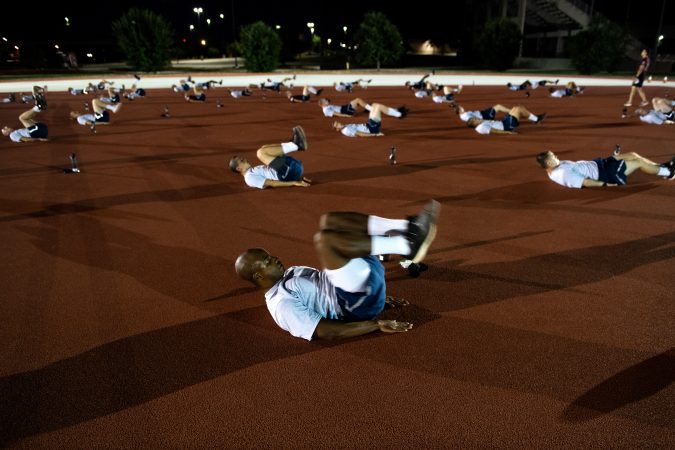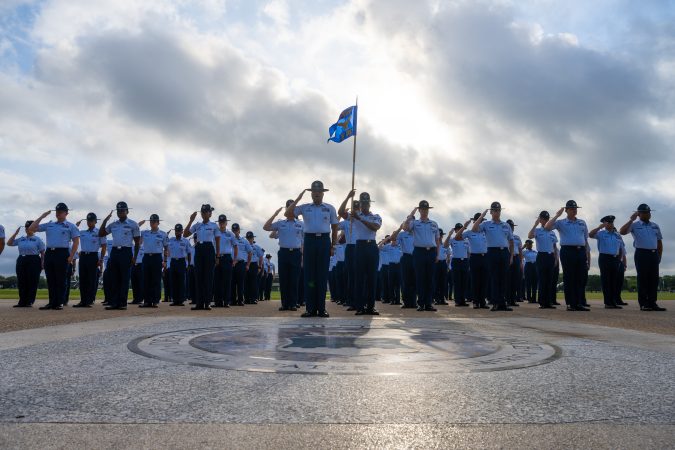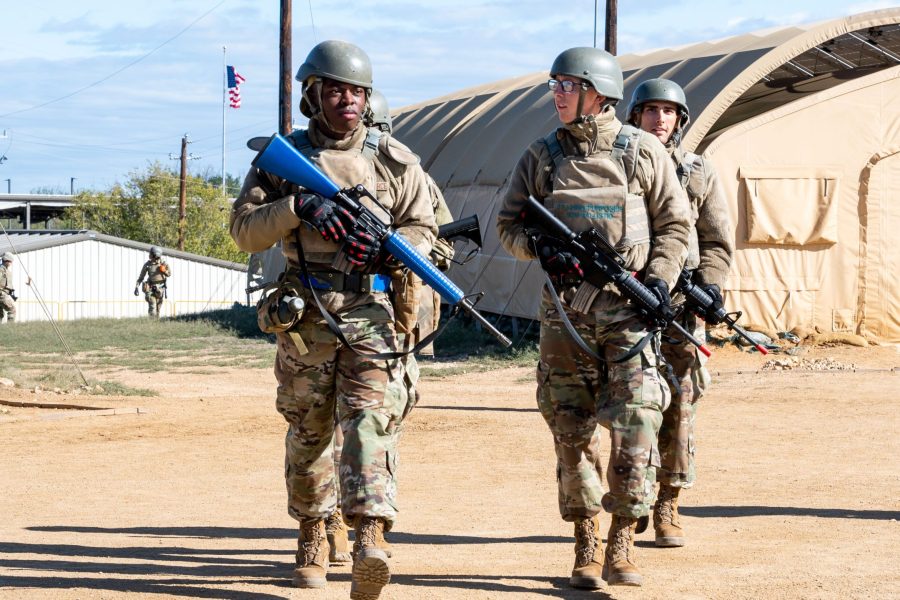NATIONAL HARBOR, Md.—The Air Force’s revamped Basic Military Training is set to launch on Oct. 7, adding more physical fitness training and new emphasis on operating in small teams for combat operations.
Dubbed BMT 2.0, the new curriculum extends morning PT from 60 to 90 minutes and reduces the time trainees spend training for drill and ceremony and keeping dorms inspection ready.
In addition, Airmen will get more exposure to live aircraft and hands-on map and compass orienteering training to better prepare them for the challenges they will face in real-world operational environments. The changes are meant to feed into PACER FORGE, the final field exercise introduced in 2022 that simulates operations at makeshift airbases as trainees might experience conducting agile combat employment operations.
The moves aim to instill a “sense of air-mindedness” so new Airmen fully appreciate how they fit into the joint force, Air Force Col. Bill Ackman, commander of the 737th Training Group, told Air & Space Forces Magazine during AFA’s Air, Space & Cyber Conference.
“The Air Force, for a long time, has struggled with what is our identity in the joint force,” Ackman said. “We have folks that enable missions to be carried out beyond the horizon but aren’t necessarily tied to that mission personally. … Right now, we do a very good job of having [trainees] follow procedures, but sometimes they leave BMT without an understanding of how they’re tied to the larger airpower missions. And that’s what we’re attempting to do.”
Most of the new curriculum launches Oct. 7, but some lessons, such as orienteering, are still being finalized, and won’t be added until late December, Ackman said.
The new curriculum for BMT 2.0 is the result of an effort that 2nd Air Force Commander Maj. Gen. Wolfe Davidson began in August 2024 to better prepare trainees for the challenges they will face in a “high-end fight” with potential adversaries like China and Russia.
Operating in Small Teams
At a fundamental level, BMT leaders are restructuring the way trainees are organized, breaking traditional training flights of 40-50 into smaller elements, in keeping with the Air Force’s ACE strategy, Ackman said.
“We’re going to focus on an element, which is a 10-to-15 person cohort,” Ackman said. “We want to evaluate their ability to operate in those small teams because that’s how they’re going to operate, most likely, in combat.”
Element leaders will be selected by instructors based on leadership potential; they will take mission-type orders and ensure trainees in their element are ready.
That’s a significant difference, said Chief Master Sgt. Whitfield Jack, the senior noncommissioned officer for the 737th. “Currently there is a position called dorm chief, who is in charge of the flight when the [instructor] is not there,” he said. “In BMT 2.0, they will be leading the entire time. They are the leaders throughout training, not just in the dorm.”
As training progresses, element leaders will be re-evaluated; instructors can change out element leaders who negatively impact team’dynamics. “It offers more opportunities for trainees to assume leadership positions,” Jack said.
Hands-On Training
Throughout training, trainee elements will undergo events designed to prepare them for the challenges they will face at PACER FORGE, so that the final exercise is really a culmination of all that they have learned.
“Right now, there’s a little disconnect between what they learn from the first five weeks and then what they get out at PACER FORGE,” Ackman said.

For example, a new weapons relay combines disassembling the inert M4 training carbines leaders introduced into BMT in July 2024 with running to teach trainees to perform tasks under stress. Trainees disassemble their carbines, do a shuttle run, and then reassemble the carbine while “competing against other elements to see how quickly they can accomplish the task,” Ackman said.
In another event, instructors set up a simulated airfield and elements receive a report that a radar site on the airfield is inoperable. They must then move as a team to the site, confirm the issue, and report it; they also must deal with a small unmanned aerial system scenario, Ackman said.
“They’re gonna see this again in PACER FORGE with a real small UAS, so this is helping to introduce things along the way, so that when they get to PACER FORGE, they’re like ‘Oh, I remember making that small UAS report,” he said.
The new curriculum also exposes trainees to live aircraft, which is a priority for teaching “air-mindedness,” Ackman said. “Right now, there is no interaction with any aircraft, and we want them to understand their role in airpower,” Ackman said.
In late December, training officials will introduce a C-130 Hercules that belongs to the Inter-American Air Forces Academy at Joint Base San Antonio-Lackland, teaching a class on aircraft fundamentals and the roles and missions of airpower, Ackman said.
“It’s the perfect aircraft to expose them to all these concepts because it is the workhorse for Air Force mobility,” he said.
Learning to Navigate
When orienteering begins late this year, it won’t be the same kind of land navigation training Soldiers and Marines get in boot camp, which focuses on finding locations while operating in the woods, but rather on understanding how to navigate within their future operating environment, Jack said.
Using the BMT training area, “we’ve got our eight squadrons, and we just lay a grid map over that,” Jack said. Trainees will see that “the 323rd [Training Squadron] is sitting at J3.” They will learn how to read a map, orient themselves to what the map, and make their way around an installation.
Instructors will have to complete the course first.
“The military training instructor cadre that we currently have come from all over the different career fields,” Ackman said. “If someone’s a finance person, they may not have much operational [field] experience, and to ask them to do orienteering with a compass for a trainee is daunting. So part of this effort for BMT 2.0 is that we have to retool the MTI school house to give them the operational flavor.”

More PT and Dedicated Recovery Time
Expanded PT will retain the traditional focus on running, pushups, and situps, while adding more high-intensity interval training such as “box jumping,” sprinting and shuttle runs.
“It’s really about building muscle endurance, cardio, and trying to get them to a better place when they graduate than they currently are,” Ackman said. “This is a means to get to a force that is more ready to potentially go into conflict.”
Increased fitness training comes as the Air Force is also increasing the run portion of its fitness test from 1.5 to 2 miles in 2026. BMT will also make the switch, Ackman said.
At the end of each day, BMT 2.0 will add a 60-minute “recovery” period before lights out, where trainees will be guided through a series of activities “to make sure that at the end of the day, they have a chance to reset mentally and physically,” Ackman said. Included will be stretching and “tactical breathing,” or box breathing, intended to lower the body’s cortisol level and lower anxiety and blood pressure.
“We understand that the trainees won’t be coming in in any better shape than they currently are, but we’re asking more of them physically,” Ackman said. “We need to give them the tools to be able to recover.”
Less Marching and Inspection Prep
Marching in formation and maintaining inspection-ready quarters are hallmarks of military culture, designed to teach discipline, attention to detail, and esprit de corps, and while those will remain, in BMT 2.0 they will get less emphasis.
“It’s going from inspection-ready to neat and orderly,” Jack said. “They still have to make their beds, but it’s neat and orderly versus I throw a quarter on the bed, and if it doesn’t bounce you have failed.”

Likewise, there will be only about half the time devoted to marching practice, Ackman said, with a cut from 40 hours of drill and ceremony training to about 20 hours.
“Drill is an effective means to an end for teaching attention to detail and team building, but I think Maj. Gen. Davidson was concerned that it became less about the means and more about the end, and we began to evaluate drill as the culmination of your performance at basic training,” Ackman said. “His focus is a PACER FORGE, which is the culminating event in a simulated combat environment. That is how you evaluate how someone has incorporated the lessons that they were taught. … You’re going to go off and you’re going to be a medical person, you’re going to be Intel, but you are tied back to generating, sustaining, defending and operating airpower.”


